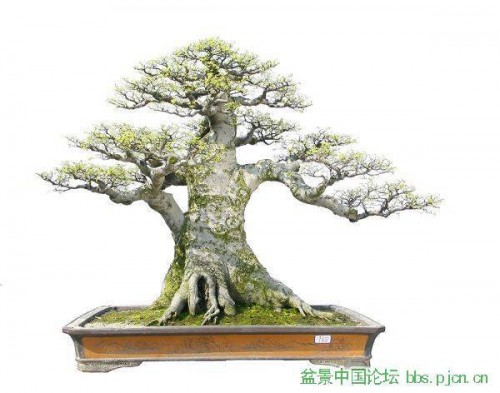
I’m guessing this impressive tree is a Chinese elm. Whatever it is, it displays much of what you’d look for in a bonsai: power, refinement, balance, excellent ramification, attractive pot, even some imperfection. I’d also venture that it’s definitely not Japanese. It’s from Rawe Laranta Ramook Bonsai.
It’s Penjing, but is it Chinese?
A couple posts ago Robert Steven offered us a lesson in the five schools of Chinese Penjing. I’m pretty sure Robert would include this tree in that vast and varied grouping, even if it’s not from China (I don’t know where it’s from). Though Robert (and others) are clear that Penjing is Chinese, I imagine he is saying that the art is Chinese in origin (much like Bonsai is Japanese in origin), not that all trees you’d call penjing are from China.
Baobob and that sculptural look
This tree looks a bit like a Baobob with its short fat trunk. Or maybe just a very foreshortened (you could say compressed) old deciduous tree that you might find standing alone in a field somewhere (if it were in a forest, you would expect it to be taller and narrower). In either case it has what you might call a sculptural look that is common in some penjing. It’s a look that seems to be more concerned with capturing the essence of a tree rather than just a scaled-down rendition of a full sized tree.
Make your bonsai feel like a tree
John Naka is famous for saying “don’t make your tree look like a bonsai, make you bonsai look like a tree.” In the case of this tree, and other penjing, you might say: don’t make your tree feel like a bonsai, make your bonsai feel like a tree.
This part is boring, even a little embarrassing, but definitely necessary
Our Holiday Sale ends Thursday. There are plenty of great deals. In fact, almost everything is discounted. Even double discounted. Your part of the deal is to buy something. Our part is to send it out to you immediately (there’s still time). And to keep Bonsai Bark posts flowing.
it is perfectly beautiful!; capturing the essence of tree, the urgency of rootedness.
Thanks Erik,
Agreed!
I’m so glad you are including John Naka, a great bonsai artist. I got yo meet him at Bill Valavanis’ bonsai meet and he was the nicest man plus a great bonsai artist. I had his books which I asked him to autograph. Then someone asked him for the secret of his success with women … he said “It’s simple, I’m not dangerous anymore.” Loved it.
He was always able to get to the nitty gritty, the kernel. That’s why saying make your bonsai look like a tree is a truism for great bonsai.
Thanks Mariël,
Another great John Naka story.
As a South African, to me this tree resembles an old Boabab tree (Adansonia digitata) standing on the African savannah. We often stood next to these huge trees, humbled and in awe. The way they grow do not follow bonsai rules, yet they remain impressive. It is great to see a tree that could be classified as a Boabab style in Charles Ceronio’s book “Bonsai styles of the world”. Lovely tree and brings enjoyment to the observer – regardless of whether we classify it as bonsai or penjing.
Thanks Adriann,
Yes, Baobab is what I thought of when I first saw it. One of these days I’d like to stand next to one too. Meanwhile, books and the web will have to do.
And yes, once again. Charles’ book is excellent. He presents dozens, if not hundreds of styles most of us don’t even know exist.
In Indonesia we call it a “Natural” style, like hundreds years old tree. Also, it showed alot at Cheng Cheng Kung website at contest gallery, he bonsai artist from Taiwan.
Thank you Hendro,
Yes, Cheng Cheng Kung is doing some amazing stuff, especially with deadwood: http://ibonsaiclub.forumotion.com/bonsai-f1/cheng-cheng-kung-s-bonsai-school-taiwan-juniper-t924.htm
Wayne,
I agree with you. Just try this link for what I meant CCK gallery http://sidiao.myweb.hinet.net/2008_e.htm . Cheers
I agree with you Wayne: this tree is perfect because is not perfect. I just love those 2 branches “pinching the eye”, against all the rules and schools.
Great stuff Hendro. Thanks for the link.
I agree with your agreement Al.
There’s often interesting tension between what gives a tree character and conventional notions of what makes a good bonsai. I think it was Roy Nagatoshi in somewhere in a back issue of Bonsai Today who said that people often get rid of a tree’s most interesting features (the ones that tell a story) in an attempt to follow bonsai conventions.
Another example is the funky nebari scar with the two little stray roots framing it. In some places, that’s serious flaw.
This is typical Lingnan school penjing. Among the main distinctive characters of Lingnan Pai penjing are the “emphasized” trunk and main branches, displayed in defoliation to demonstrate the simple and clear branches arrangement, the perfect “clip-and-grow” ramification structure especially the twigs, asymmetrical composition with the “flowing” lower branch, natural scars as accentuation instead of defective, sufficient void space and the use of shallow and wider pot to suggest more panoramic image.
Hendro, “natural” is not a style but a terminology to tell the natural image of the tree. What make a bonsai looks natural is the ideal ramification structure arranged in irregular shape of foliation, not too much refined and more conture on the foliage edges. When everything is too neat, the bonsai will never look natural. This is the essense of Chinese penjing “yuan yi zi ran, gao yi zi ran” …..
My third book will be coming about penjing….
https://bonsaibark.com/2010/12/11/robert-steven-critiques-a-black-pine-and-offers-some-insights-into-the-five-schools-of-penjing/